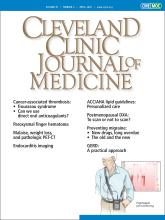Article Figures & Data
Tables
Severe hypercholesterolemia Initiate high-intensity statin therapy immediately, irrespective of 10-year risk of atherosclerotic cardiovascular disease (ASCVD) Adding ezetimibe is reasonable if low-density lipoprotein cholesterol (LDL-C) is ≥ 190 mg/dL or there is less than 50% reduction in LDL-C levels with maximal tolerated statins Consider adding a proprotein convertase subtilisin/kexin type 9 (PCSK9) inhibitor in patients with heterozygous familial hypercholesterolemia or with LDL-C ≥ 220 mg/dL with maximally tolerated statins and ezetimibe Diabetes mellitus in adults Irrespective of 10-year ASCVD risk, initiate moderate-intensity statin therapy immediately Aim for reduction of LDL-C by at least 50% Adults age 40–75 with LDL-C levels 70–189 mg/dL Before starting statins, engage in clinician-patient risk discussion, evaluating risk factors, 10-year ASCVD risk, risk enhancers (Table 2), patient’s preference, costs, and adverse effects of statins Use coronary artery calcium score to guide decision if risk is still unclear Children and young adults Assess risk factors in children age 0–19 years Initiate statin therapy if patients have severely abnormal lipid profiles or clinical presentation of familial hypercholesterolemia and cannot be treated by 3 months lifestyle therapy Ethnicity Review racial and ethnic features that can influence ASCVD risk and intensity of treatment (Table 3) Adults with chronic kidney disease Starting moderate-intensity statin alone or in combination with ezetimibe can be useful Adults with chronic inflammatory disorders and HIV In adults age 40–75 with LDL-C 70–189 mg/dL with a 10-year ASCVD risk of over 5%, discuss moderate- or high-intensity statin therapy Women History of premature menopause (before age 40) or history of pregnancy-related disorders (hypertension, pre-eclampsia, gestational diabetes, small-for-gestational-age infants, and preterm deliveries) are risk-enhancing factors and should influence lifestyle and pharmacologic therapy decisions Based on information in references 1 and 2.
Family history of premature atherosclerotic cardiovascular disease (in men age < 55 or in women age < 65) Primary hypercholesterolemia
Low-density lipoprotein cholesterol 160–180 mg/dL
Non-high-density lipoprotein cholesterol 190–219 mg/dLMetabolic syndrome: 3 or more of the following:
Increased waist circumference by ethnically appropriate cut points
Fasting triglyceride level > 150 mg/dL
High blood pressure
Elevated glucose
Low high-density lipoprotein cholesterol (< 40 mg/dL in men, < 50 mg/dL in women)
Chronic kidney disease (estimated glomerular filtration rate 15–59 mL/min/1.73 m2)Chronic inflammatory conditions (eg, psoriasis, rheumatoid arthritis, lupus, human immunodeficiency virus infection, acquired immunodeficiency syndrome) History of premature menopause (age < 40) and history of pregnancy-associated conditions that increase later risk of atherosclerotic cardiovascular disease such as preeclampsia High-risk ethnicity or race (eg, South Asian) Lipids or biomarkers associated with elevated risk
Persistently elevated hypertriglyceridemia (≥ 175 mg/dL nonfasting)
Elevated high-sensitivity C-reactive protein (≥ 2.0 mg/L)
Elevated lipoprotein (a) (≥ 50 mg/dL or ≥ 125 nmol/L) (relative indication for measurement: family history of premature atherosclerotic cardiovascular disease)
Elevated apolipoprotein B (≥ 130 mg/dL) (relative indication for measurement: triglycerides ≥ 200 mg/dL)
Ankle-brachial index < 0.9Reprinted from Grundy SM, Stone NJ, Bailey AL, et al. 2018 AHA/ACC/AACVPR/AAPA/ABC/ACPM/ADA/AGS/APhA/ASPC/NLA/PCNA guideline on the management of blood cholesterol: executive summary: a report of the American College of Cardiology/American Heart Association Task Force on Clinical Practice Guidelines. J Am Coll Cardiol 2019; 73(24):3168–3209. doi:10.1016/j.jacc.2018.11.002, with permission from Elsevier.
- TABLE 3
Racial and ethnic differences in atherosclerotic cardiovascular disease risk and coronary artery calcium scores
Asian Hispanic and Latino Black, Native American, and Alaskan ASCVD risk South Asiansa have higher ASCVD risk than East Asiansb Individuals from Puerto Rico have the highest ASCVD risk15
CVD mortality is higher in Hispanics than whitesIncreased ASCVD risk14
Greater rates of CHD events compared with non-Hispanic white populations17CAC score South Asian men have similar CAC burden to non-Hispanic white men, but higher CAC compared with blacks and Latinos18
South Asian women have similar CAC scores compared with other ethnic and racial groups18Lower CAC burden compared with Asian-Americans and non-Hispanic whites16 Lower CAC scores compared with whites and Hispanics16 ↵a Individuals from Bangladesh, India, Nepal, Pakistan, and Sri Lanka make up most of the South Asian group.
↵b Individuals from Japan, Korea, and China make up most of of the East Asian group.
ASCVD = atherosclerotic cardiovascular disease; CAC = coronary artery calcium; CHD = coronary heart disease; CVD = cardiovascular disease
Patient subgroup Guideline recommendation At very high riskb If low-density lipoprotein cholesterol (LDL- C) levels are ≥ 70 mg/dL with the maximal tolerated statin therapy, it is reasonable to add ezetimibe
If LDL-C level is ≥ 70 mg/dL on maximal tolerated statin and ezetimibe, it is reasonable to add a PCSK9 inhibitorNot at very high risk Age ≤ 75 Goal is LDL-C reduction by 50%
Use moderate-intensity statins if high- intensity statins are not tolerated
If LDL-C ≥ 70 mg/dL on high-intensity statins, it is reasonable to add ezetimibeAge > 75 Starting or continuing either moderate- or high-intensity statins is reasonable ↵a Secondary prevention refers to patients with clinical atherosclerotic cardiovascular disease (ASCVD), ie, those with a history of acute coronary syndrome, myocardial infarction, stable or unstable angina, arterial revascularization, stroke, transient ischemic attack, or peripheral artery disease.
↵b Very high risk includes a history of multiple major ASCVD events or 1 major ASCVD event and multiple high-risk conditions (age ≥ 65, heterozygous familial hypercholesterolemia, history of coronary artery bypass surgery or percutaneous coronary intervention, diabetes mellitus, hypertension, chronic kidney disease, current smoking, persistently elevated LDL-C, or history of heart failure).
Based on information in reference 1.






